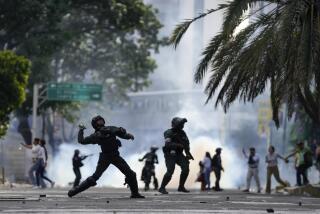Commentary : PERSPECTIVE ON THE AMERICAS : The Andes Are Falling Apart
- Share via
Forty years ago, fresh from his triumphant takeover of Havana after a guerrilla campaign launched from Cuba’s Sierra Maestra mountain region, Fidel Castro warned that the Andes would soon become the “Sierra Maestra of South America.”
But, despite Castro’s efforts to back leftist groups in the Andean countries, no successful revolutionary movement emerged there during the 1960s and 1970s. The Shining Path and Tupac Amaru uprisings in Peru gained considerable strength in the 1980s and early 1990s and shook that society, but these insurgencies were eventually contained and largely extinguished. Nowhere else in the Andean region did revolutionary movements even come close to power.
Far from succumbing to revolution, Colombia and Venezuela came to be widely regarded as bastions of democratic stability; during the mid-1970s, they were the only South American nations not ruled by their armed forces, and for years thereafter they were often cited as well-established (if imperfect) democracies. Bolivia and Ecuador--long accustomed to chronic instability, frequent military interventions and dire poverty--evolved over the past two decades toward democratic governance and improved economic performance. And Peru emerged from difficult periods of both military and civilian populism, economic deterioration and Shining Path’s virulence to enter a period of economic growth early in the 1990s, under the leadership of the democratically elected, if unmistakably authoritarian, Alberto Fujimori.
Overall, the Andean countries in the early ‘90s seemed to be doing reasonably well, as part of a continent on the move; there were growing problems, to be sure, but they seemed surmountable.
Now, however, at the end of the ‘90s, the Andean region is in dire straits. Castro’s vision of revolutionary change is still not apt, but the Andean countries are engulfed in profound crises.
Colombia
Colombia’s decline is the most dramatic. The background political violence of the 1940s, ‘50s, and ‘60s has given way during the last decade to increasingly frequent and highly visible assassinations and kidnappings. Colombia is losing three simultaneous and mutually interactive wars: with the powerful narcotics enterprises, with the burgeoning guerrilla armies and with the fast-growing and vicious right-wing paramilitary organizations. Years of escalating insurgencies, urban violence and social deterioration--compounded by the country’s worst economic recession in 60 years--together have produced a national crisis of values, institutions and confidence.
The high hopes that greeted the election of Andres Pastrana as Colombia’s president in mid-1998 have been dashed; the credibility of virtually all the country’s established institutions and leaders has plummeted, and a bleakly pessimistic national mood has taken hold. Massive national “marches of silence” attest both to public outrage and to the absence of any articulated programs that can command broad support. That 60% of Colombians polled recently favored a U.S. military intervention in their country reveals a desperate impasse.
Venezuela
The situation in neighboring Venezuela, the largest source of imported petroleum for the United States, is very different but is also deeply disturbing. Discredited political and economic establishments have been brushed aside, and the two main political parties have imploded. A retired army lieutenant colonel, Hugo Chavez, handily won election as president and has subsequently swept into power a largely handpicked constituent assembly with extraordinary authority.
Last week, the constituent assembly in effect dissolved the Congress and announced its intent to radically restructure the judiciary, leading the president of the Supreme Court to resign, stating that the court should commit suicide rather than suffer assassination. No one seems to know exactly what to expect next from Chavez, who, earlier in his career, had led a bloody military coup attempt. And in fact he appears to be quite systematically pursuing his announced radical program to revamp what he regards as a thoroughly corrupt country.
In that context, moreover, Chavez’s expressed interest in Simon Bolivar’s pan-Andean ideal--combined with Chavez’s open invitation to Colombia’s guerrilla leaders to confer with him on Venezuelan soil--lead some to wonder aloud whether he has in mind an alliance to destroy Colombia’s weakened system.
Peru
In Peru--where ethnic outsider Fujimori has already overturned entrenched patterns of power, privilege and authority--the country’s previously weak institutions have been further undermined by years of personalist rule; attacks on the Congress, the judiciary, the media and other erstwhile power centers, and continuing repression. Fujimori’s tacit alliance with a shadowy group of military intelligence officers has solidified his grip, and many signs suggest that he now intends to flout constitutional restraints and engineer a third consecutive presidential term. Meanwhile, the bloom is off Peru’s economy. Foreign investment has dropped and unemployment is rising, fueling a potential political tinderbox.
Ecuador
In Ecuador, where the previously elected president was ousted by Congress for alleged insanity in a move of dubious constitutionality, the current president, Jamil Mahuad, has been unable to turn around an economy buffeted by international financial turmoil, falling commodity prices, labor unrest and the destruction caused by the El Nino floods. Last week, Ecuador--facing 7% negative growth and 55% inflation for 1999--narrowly averted becoming the first Latin American country in many years to default on its international debt. It has requested a 30-day delay on meeting its interest payments and has appealed for substantial debt reduction.
Bolivia
In this regional company, surprisingly, Bolivia’s stolid adherence to the forms and norms of democratic politics and its continued implementation of market-oriented economic reforms looks relatively stable and attractive. But Bolivia’s current president, retired Gen. Hugo Banzer, is himself an unpleasant reminder of an earlier period of repressive military rule, and Bolivia’s economic and political reforms remain fragile.
Broad rhetoric about hemispheric community and the bold vision of free trade from Alaska to Patagonia ignore the realities of Andean upheaval. Narcotics, insurgencies, kidnappings, murder and extortion, deep poverty and vast economic inequities, human rights violations, weakening institutions, rampant corruption and decaying values, public disenchantment and despair--all contribute to a sense of turmoil. The inter-American community, particularly the United States, needs to bring this region’s troubles into much better focus.
More to Read
Sign up for Essential California
The most important California stories and recommendations in your inbox every morning.
You may occasionally receive promotional content from the Los Angeles Times.










